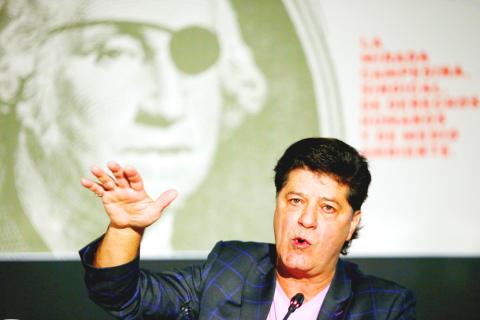The head of Canada’s biggest private-sector union, Unifor, on Friday headed to Mexican Senate, promising to fight at the North American Free Trade Agreement (NAFTA) trade pact talks for improved Mexican wages and free collective bargaining as a way of benefiting workers across North America.
The issue of tougher labor standards has emerged as a key sticking point in the talks to update NAFTA and has brought disparate groups of workers from across the region closer to US right-wing populists.
“There will not be an agreement until the Mexican team agrees to free collective bargaining, the elimination of yellow unions and that Mexican workers get paid what they deserve,” Unifor president Jerry Dias said.

Photo: Reuters
The event held in a side chamber of the Senate was organized by umbrella organization Mexico, “Better Without Free Trade Agreements,” which represents dozens of social organizations and unions.
Dias said that low wages have not only hurt Mexican workers, but have also prompted manufacturing jobs in Canada and the US to leave for Mexico.
By including much tougher labor standards in an updated NAFTA the issue could be dealt with head on, he said. “When you start talking about low wages, we can deal with that under the dispute mechanism as an unfair subsidy.”
Participants of the event planned to march later in the day to the upscale Camino Real hotel, where the fifth round of talks for NAFTA are being held.
Negotiators met in Mexico City for the fifth of seven planned rounds that are due to wrap up by the end of March next year to avoid affecting Mexico’s presidential election.
“We’re just getting started. There’s a long ways to go. It’s a challenging negotiation,” chief Canadian negotiator Steve Verheul told reporters.
Canadian and Mexican officials initially said they would simply not discuss contentious US proposals such as a five-year sunset clause and boosting the North American content of cars to 85 percent from 62.5 percent.
The focus in Mexico City would be on making arguments to the US side as to why their proposals as written would not work, a Canadian government source said.
Canada, the source added, was happy to discuss so-called rules of origin governing car content, but said the 85 percent figure was impossible.
Canadian sources on Thursday said they were open to a Mexican proposal to review NAFTA every five years rather than the US plan to bring in a sunset clause that would automatically terminate the deal if it was not renegotiated.
A Mexican official said the US needed to make clear what it hoped to achieve with tougher rules of origin, given the difficulty of raising the threshold.
Noting that 85 percent North American content was not feasible, the official said Mexico did not want “a rupture” to occur in the talks.
Washington also wants NAFTA to set a 50 percent minimum US content requirement for cars, which Canada and Mexico say cannot work.
“Once [the Americans] have explained all that, we can see about finding common ground,” the Mexican official said.
Meanwhile, the US on Friday revised its negotiating objectives for revamping the trade pact, purposing to eliminate Canada’s import tariffs on dairy, poultry and egg products, and to allow more protections for seasonal US produce that is sensitive to imports from Mexico.
The US Trade Representative’s office said it is keeping in place most of its NAFTA objectives, first published in July, including a first-ever goal of reducing US trade deficits.
“If we are able to achieve these objectives, we will both modernize and rebalance NAFTA to better serve the interests of our workers, farmers, ranchers and businesses,” US Trade Representative Robert Lighthizer said in a statement.
The new objectives on investment and intellectual property rights add considerable detail, partly aimed at reflecting existing demands and partly aimed at setting precedents for future trade agreements.

GROWING OWINGS: While Luxembourg and China swapped the top three spots, the US continued to be the largest exposure for Taiwan for the 41st consecutive quarter The US remained the largest debtor nation to Taiwan’s banking sector for the 41st consecutive quarter at the end of September, after local banks’ exposure to the US market rose more than 2 percent from three months earlier, the central bank said. Exposure to the US increased to US$198.896 billion, up US$4.026 billion, or 2.07 percent, from US$194.87 billion in the previous quarter, data released by the central bank showed on Friday. Of the increase, about US$1.4 billion came from banks’ investments in securitized products and interbank loans in the US, while another US$2.6 billion stemmed from trust assets, including mutual funds,

AI TALENT: No financial details were released about the deal, in which top Groq executives, including its CEO, would join Nvidia to help advance the technology Nvidia Corp has agreed to a licensing deal with artificial intelligence (AI) start-up Groq, furthering its investments in companies connected to the AI boom and gaining the right to add a new type of technology to its products. The world’s largest publicly traded company has paid for the right to use Groq’s technology and is to integrate its chip design into future products. Some of the start-up’s executives are leaving to join Nvidia to help with that effort, the companies said. Groq would continue as an independent company with a new chief executive, it said on Wednesday in a post on its Web

Even as the US is embarked on a bitter rivalry with China over the deployment of artificial intelligence (AI), Chinese technology is quietly making inroads into the US market. Despite considerable geopolitical tensions, Chinese open-source AI models are winning over a growing number of programmers and companies in the US. These are different from the closed generative AI models that have become household names — ChatGPT-maker OpenAI or Google’s Gemini — whose inner workings are fiercely protected. In contrast, “open” models offered by many Chinese rivals, from Alibaba (阿里巴巴) to DeepSeek (深度求索), allow programmers to customize parts of the software to suit their

JOINT EFFORTS: MediaTek would partner with Denso to develop custom chips to support the car-part specialist company’s driver-assist systems in an expanding market MediaTek Inc (聯發科), the world’s largest mobile phone chip designer, yesterday said it is working closely with Japan’s Denso Corp to build a custom automotive system-on-chip (SoC) solution tailored for advanced driver-assistance systems and cockpit systems, adding another customer to its new application-specific IC (ASIC) business. This effort merges Denso’s automotive-grade safety expertise and deep vehicle integration with MediaTek’s technologies cultivated through the development of Media- Tek’s Dimensity AX, leveraging efficient, high-performance SoCs and artificial intelligence (AI) capabilities to offer a scalable, production-ready platform for next-generation driver assistance, the company said in a statement yesterday. “Through this collaboration, we are bringing two